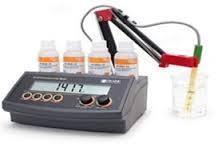General Information:
The electrical conductivity of water is the property of that solution to conduct electric current, depending on the amount of ions present in the water.
The referential after which the analysis is performed:
The analysis for determining the conductivity of drinking water is performed within its own laboratory according to the national standard SR EN 27888:1997.
Principle of the method:
The determination of the conductivity of drinking water is performed with the help of the electronic conductometer provided with a glass electrode.
Causes of sample rejection – quantity of unsuitable sample, samples collected in inappropriate containers, samples not properly labeled, etc.
Harvesting container – clean container.
Quantity of sample required to perform the analysis - minimum 100ml.
Necessary processing after harvesting – not required.
Sample stability – freshly harvested water is stable for 2 days at 2-8°C or 6 hours at ambient temperature.
Method of analysis - electrochemical.
Reference values according to the Water Law1)
| Parameter / Unit of measurement | CMA value (Maximum permissible concentration) |
|
|
max. 2,500 |
2) Water should not be aggressive
Recommendations for performing the analysis / Effects of exceeding the reference values –
Ionized water is used by the body uniquely. H2O molecules adhere to each other, forming bunches (clusters) of molecules. While in ordinary water a bunch consists of 12-18 molecules, ionized water has hexagonal bunches, consisting of only 6 molecules. This smaller structure penetrates the cells much easier than "normal " water. The structure of bunches appears after ionization. This procedure increases the hydration capacity of water up to 6 times, because water is absorbed, enters the cells and is used by the body much easier. To reduce conductivity, an installation with reverse osmosis or other specific installations is used.
bibliography:
- LAW 458/2002 with subsequent amendments to Law no. 311/2004, Government Ordinance no. 11/2010, Law no. 124/2010 and Government Ordinance no. 1/2011






